
Kes is an important part of the Sikh identity but it also carries social, cultural, and political meaning for more than just Sikhs. Recently, a film student from NYU explored this less explored cross-cultural perspective by speaking with 3 individuals from various backgrounds in an interesting (and short-18 minute) documentary.
The film engages with a Sikh (Sonny Singh from the Sikh Coalition’s New York office), an African-American woman, and a woman with trichotillomania – a disorder that causes the sufferer to compulsively pull out hair. We often consider kes in the context of religion, beauty, and identity; but rarely do we do so in a cross-cultural perspective (unless you grew up in a culturally diverse community). The film is thoughtful and thought-provoking, so I’ll let it speak for itself. It includes footage from the recent Sikh Day parade in New York City, as well as a pagh tying competition in Richmond Hill.
[hat tip: sonny]
Hair… As one of the most important aspects of how others see us, how has our hair become interwoven with issues of race, religion, beauty, and identity?
Sikhism mandates that the hair is never cut. We explore the rationale behind this and the discrimination that Sikhs face today in a post 9-11 world.
Many women of African descent grow up to think negatively about their natural hair. So begins the burdensome, expensive, and often painful process of weaves and chemical straightening, as a however subconscious attempt to achieve a homogenized concept of beauty. We speak to a woman who takes pride in her natural hair and is committed to show others how truly beautiful “nappy” hair can be.
Sometimes what we do with our hair is not a choice. Trichotillomania is a disorder that causes the sufferer to compulsively pull out hair. We will meet a long-term lash/brow puller who describes how people have reacted to her disorder and how these experiences have shaped her. [link]
The crisis of Sikh identity was once described to me in very simple terms; most Sikh males no longer want to look like Sardars and most Sikh girls don’t want to marry Sardars. In fact, I distinctly remember several Sikh guys that I went to school cutting their hair for the simple reason of “getting girls”.
Over the past few years, we’ve seen efforts on many fronts to confront this trend, including beauty pageants (Mr. Singh International), Sikh models (Sunny Singh Caberwal of Kenneth Cole and now GQ fame). Now, in a twist on the standard Sikh dharmak or religious song, Taranmpreet has released a track called “Teri Meri Bas: Sat Sri Akal”.

If you’re in the DC area on Friday and are free in the afternoon, head over to the Library of Congress at 1:00 pm. Nikky Guninder Kaur Singh, author of “The Feminine Principle in the Sikh Vision” among other works, will be speaking in the  Mary Pickford Theatre on the 3rd floor of the Madison Building.
Mary Pickford Theatre on the 3rd floor of the Madison Building.
When: May 8, 1:00 pm-2:00 pm
Where: Mary Pickford Theater, 3rd Floor, James Madison Building,Library of Congress
101 Independence Ave., SE, Washington, DC 20540
(Metro stop: Capitol South on the Blue/Orange Line)
What: “The Feminine Principle in the Sikh Vision”
by Dr. Nikky Guninder Kaur Singh, Crawford Family Professor of Religious Studies at Colby College
Click on flyer to see full-size.
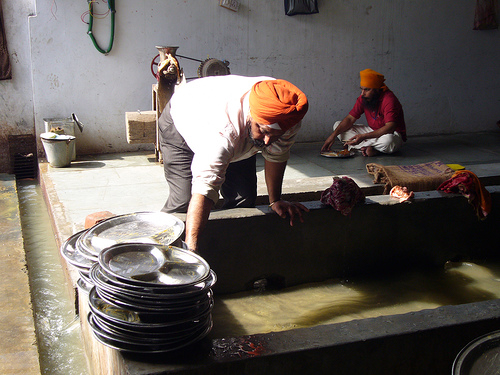 On TLH we have discussed Green Gurdwaras. Part of this green initiative is to use steel plates (i.e. thaals) and cutlery instead of the common paperware. A couple of weeks ago at a local Gurdwara langar, I saw steel plates being used that had been stored away in cupboards for years. Every week disposable cups, plates, spoons and forks were used by the sangat. Somehow in a community with a growing immigrant Punjabi population disposable means modernity. I remember watching sangat members come stand in the standard langar line and show surprise as they reached the front and saw large piles of steel plates. The reactions were amazing. We had aunties with twitched noses who continued to scrub the steel plates although they had been cleaned and washed the night before and showed no signs of being dirty. Uncles made comments like, “hun taan aapaan Punjab ton nikal gaye, a hun desi kamm ithhe vi shuru kar taa”. Others just smirked and laughed.
On TLH we have discussed Green Gurdwaras. Part of this green initiative is to use steel plates (i.e. thaals) and cutlery instead of the common paperware. A couple of weeks ago at a local Gurdwara langar, I saw steel plates being used that had been stored away in cupboards for years. Every week disposable cups, plates, spoons and forks were used by the sangat. Somehow in a community with a growing immigrant Punjabi population disposable means modernity. I remember watching sangat members come stand in the standard langar line and show surprise as they reached the front and saw large piles of steel plates. The reactions were amazing. We had aunties with twitched noses who continued to scrub the steel plates although they had been cleaned and washed the night before and showed no signs of being dirty. Uncles made comments like, “hun taan aapaan Punjab ton nikal gaye, a hun desi kamm ithhe vi shuru kar taa”. Others just smirked and laughed.
There were also positive reactions where aunties and uncles supported the langar sevadars for reintroducing steel plates. These sangat members felt that these plates helped reduce waste while encouraging the action of seva. Interestingly, they said more seva is done by cleaning jutha plates than by just throwing them away. By cleaning jutha plates, it reinforced a sense of humility of cleaning other peoples’ waste. In addition, some people showed a lot of humility by refusing to allow the sevadars to take and wash their plates. For example, an elderly woman, who had difficulty walking, slowly took her plate inside the kitchen and washed it herself. Lastly, a number of sevadars, aside from the family doing langar seva that week, decided to help clean plates. An assembly line of cleaners and dryers was set-up. Some spoke and others just quietly felt the spirit of doing seva together. Ultimately, by reintroducing steel plates the spirit of seva was rekindled in a new way.
Good Morning.
I will be taking care of all your problems today. So sit back, relax, and enjoy the rest of your day!
-God
This is what the sign on the wall read at the Salvation Army on the North side of Chicago. Prior to volunteering there, I only knew stereotypes of the homeless and hungry…just what you see on TV. But it didn’t take long for those stereotypes to break down. The people we served meals to were happy, smiling, polite and full of energy. What surprised me most, was their deep sense of spirituality. Not only did I find this in my conversation with folks, but even in their greeting. My standard, “Good morning, how are you?” was often replied with “Blessed” or “In His Grace”, many with bible in hand.
I used to wonder, how could people so hard on their luck, have so much faith? I have seen so many times with family and friends, after they’ve suffered difficult circumstances or loss, God and religion are the first things questioned, i.e. “How could God do this to me?”
Many students face physical and psychological bullying in schools- elementary, middle, and high. But Sikh students, male and female, often face especially severe bullying. Over the past couple years, some severe cases have come into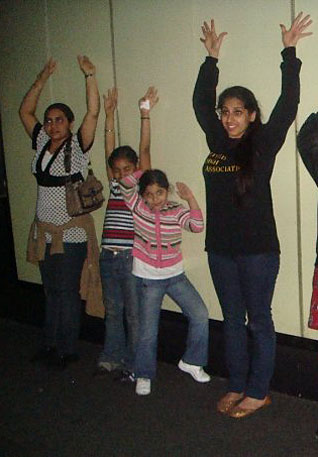 the public eye, including one teenager’s patka being set on fire, and others whose hair was forcibly cut. For statistics on the prevalence of harassment against Sikh students in New York schools, check out the Coalition’s report, “Hatred in the Hallways.”
the public eye, including one teenager’s patka being set on fire, and others whose hair was forcibly cut. For statistics on the prevalence of harassment against Sikh students in New York schools, check out the Coalition’s report, “Hatred in the Hallways.”
One pro-active student at Baruch College (of the City University of New York) has come up with a simple and creative way to provide support to kids facing harassment. Through his school’s Sikh Student Association, he started a mentoring program called Sikh Scouts. The students, aged 5-12 are paired with older Sikhs of the same gender, and go on a day’s outing together.
Sikh Scouts is essentially a small-scale Sikh youth mentoring event that aims to forge and develop a long-lasting relationship with children in need of good Sikh role models to help them guide them on the path of Sikhi. [link]
One of the students from Baruch that participated in the program wrote about the experience.
After they warmed up to us and broke through their initial shyness, the kids couldn’t stop talking about their favorite movies, TV shows and music – the Jonas Brothers and what not. And in between all of that, we got down to the serious issues: a majority of the kids did not enjoy school and felt uncomfortable because of harassment or teasing by their peers. [link]
There might not be much that anyone, including the older Sikh Scouts, can do to make the bullying stop- after all, kids will be kids. But what we older Sikh students can do for our younger counterparts is to be a source of strength, share insights about why it’s important to be comfortable with who you are whether it fits someone else’s definition of cool or not, and be there to offer advice for specific situations. There are things we’ve learned in hindsight that can benefit those facing the same harassment today.
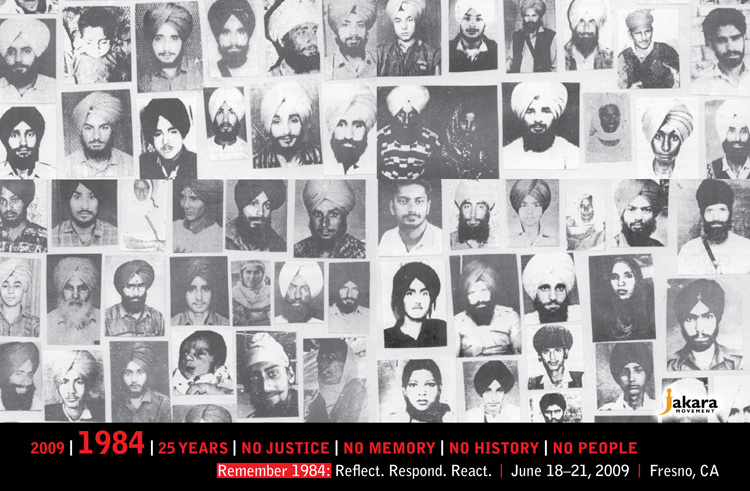
The topic of 1984 is hardly new in The Langar Hall and despite protestations from some amnesia-desiring commenters, we will not forget the Shaheeds of Darbar Sahib, the pograms in Delhi, the Ghallughara against the Sikhs from 1978-1995, or even the continuing impunity that continues today.
We have highlighted many events in the past and we will contine to do so.
In that spirit, I strongly urge TLH readers to attend this year’s Jakara Movement conference in Fresno, CA from June 18-21st. A number of invited guests’ names will be announced in the upcoming week. The title of the conference is “Remember 1984: reflect. respond. react.”
2009 | 1984 | 25 years | No justice | No memory | No history | No people
Despite the fact that many wish to forget the events that befell and have shaped the Sikh Nation, it is vital for the ‘next generation of Sikhs’ to be aware of our past and understand how it shapes our present and our future. While twenty-five years have passed since the attack on our sacred home, much has changed and much has remained the same. For the Nishan Sahib of our Nation to remain tall, it is for us to study our history, remember the past, and continue the fight for justice.
This year at Jakara, we will Remember 1984 and celebrate those Kaurs and Singhs that made the ultimate sacrifice for our Qaum.
Join us in Fresno as we Remember 1984: Reflect. Respond. React.
Register here TODAY and avoid a late fee. Below the fold you’ll find the agenda. See you there!
 Go to virtually any diasporan Sikh’s house that has an interest in Sikhi and you will find the ubiquitous blue book. On the cover is a dashing picture of Shaheed Jarnail Singh Ji Khalsa Bhindranwale. The title: Fighting For Faith and Nation: Dialogues with Sikh Militants. While too few Sikhs actually complete the book to those that are patient and willing, anthropologist Cynthia Keppley Mahmood explores the world of Sikh militants through their own voices, allowing them to air the very humanity that continues to be denied by a totalitarian state machinery.
Go to virtually any diasporan Sikh’s house that has an interest in Sikhi and you will find the ubiquitous blue book. On the cover is a dashing picture of Shaheed Jarnail Singh Ji Khalsa Bhindranwale. The title: Fighting For Faith and Nation: Dialogues with Sikh Militants. While too few Sikhs actually complete the book to those that are patient and willing, anthropologist Cynthia Keppley Mahmood explores the world of Sikh militants through their own voices, allowing them to air the very humanity that continues to be denied by a totalitarian state machinery.
At a time when even too many Sikh authors and scholars were silent as Dr. Mahmood, herself, laments:
“Sikh Studies,” a traditionally Orientalist field that has consciously steered clear of the topic of conflict in Punjab, even as tens of thousands of Sikhs perished, wants us to look at medieval religious texts while the heart of Sikhism is in flames. If we touch the fire, if then too we burn and say ouch! – then we are shunned. But then again, academia has never done well in perilous times.
The Sikhs found two strong voices who I call our Sikh Bibiyan of the Academy – Joyce Pettigrew and Cynthia Keppley Mahmood. In fact, Sikhs who have never had the fortune to meet them, lovingly refer to them by their first names [as if they are part of our family] – Joyce and Cynthia [contrast this with those involved in “Sikh Studies”, who are only known by their last names “McLeod”, “Oberoi”, etc.] Cynthia’s book is a classic and its place on the bookshelf of every diasporan Sikh is every bit warranted. If it is not on yours, make sure to add it.
While all this is covering the familiar, what inspired her to write and give pen to the voices of Sikh militants is every bit as inspiring as those that she interviewed. In my opinion just as those that inspire by fighting for faith and nation, Cynthia is a fighter, gifted with courage and inspiration.
As part of Sikh Chic’s “1984 and I” series, Cynthia reveals her own personal story for the first time:
In this deeply personal account, I describe for the first time how I was assaulted, beaten and raped by a gang of hired thugs or rogue police in a north central Indian state during fieldwork in 1992. A graphic narrative of this event leads into a brief meditation on the sorts of things readers would typically prefer not to know, and on our compulsion as engaged anthropologists to bring them into the conversation anyway. I conclude with the persisting hope of survivors of violence – like many of our ethnographic interlocutors in arenas of conflict – that healing is possible and that change toward justice can occur. Finally, I write of an anthropology that speaks from a spiritual, political and intellectual paradigm which recognizes that, unspoken or not, values of the heart are as central to our field as those of the mind. [Cynthia Keppley Mahmood, Senior Fellow in Peace Studies, Department of Anthropology, University of Notre Dame, U.S.A.]
I encourage ALL to read her entire piece.
 Next month marks the two year anniversary since the Shahadat of Bhai Kamaljit Singh. It has been quite some time since I last blogged about Dehra Sacha Sauda and unfortunately maybe I am also guilty of only following the story as the Indian media does or does not.
Next month marks the two year anniversary since the Shahadat of Bhai Kamaljit Singh. It has been quite some time since I last blogged about Dehra Sacha Sauda and unfortunately maybe I am also guilty of only following the story as the Indian media does or does not.
It was at the end of 2007, when this blog was first starting out, when I wrote about the ‘Sikh Successes of 2007’ with the incident of the confrontation of Dehra Sacha Sauda as #1 on my list. This week, I read an interesting synthesis by two French graduate students – Lionel Baixas et Charlène Simon. Lionel is completing his PhD in political science and is interested in democracy in South Asia, while Charlène is finishing her PhD in anthropology and has worked on issues related to the Ravidassia religious movement.
While I have commented on some of these issues, their recent article, titled “From Protesters to Martyrs: How to Become a ‘True’ Sikh” re-evaluates the Dehra Sacha Sauda issue through interviews and fieldwork conducted last April in Punjab and Haryana. Their abstract is as follows:
This article studies the protest which started in Punjab in May 2007 following a ceremony performed by Baba Gurmeet Ram Raheem Singh (GRRS), head of Dera Sacha Sauda, which was considered as blasphemous by a section of the Sikh community. The aim of this article is to understand the motivation of the actors of the protest itself: How did the Sikh protesters legitimate their reaction one year later? What kinds of reasons have led hundreds of Sikhs from very different social background to take the streets? What kind of emotions played a role in the Sikhs’ mobilization?
It seems like Canada is showcasing one socially conscious Sikh rapper after another. TLH has covered “Humble The Poet” and now here is “Sikh Knowledge” from Montreal. Sikh Knowledge raps with Lotus on issues effecting the 2nd generation and marginalized peoples.
Kanwar Anit Singh Saini, a.k.a. Sikh Knowledge, is the son of Punjabi Sikh immigrants. He works in the field of speech pathology where he contributes his musical knowledge to the health sciences field.
Check out his songs below and let us know what you think!
Disclaimer: There are graphic descriptions and swear words in the videos below.
On TLH we have posted on the importance of Punjabi/Khalsa Schools. I have found that despite many students’ resistance to attend these schools, they plant the seeds for future exploration into Sikhi. At the age of 12 you may think you are too cool for school on Sundays, but at 19-20 or even 30 that experience creates a base for you to delve more deeply into your spiritual identity. Thus, I think it is extremely important that each Sikh community have at least one good Punjabi/Khalsa school. Ideally, I would want each Gurdwara to have one.
However, Punjabi/Khalsa Schools run into problems because in some way or another they become linked with communal politics. Most often this politics infiltrates schools within Gurdwaras. I think a fundamental component of a Gurdwara is a Punjabi/Khalsa School as is a Langar Hall. However, for many Gurdwaras, Punjabi/Khalsa Schools are a last priority. Gurdwara committees will fund new kitchen appliances before making a commitment to continually fund a Punjabi/Khalsa School. Thus, some community members have decided to create Punjabi/Khalsa Schools outside of the Gurdwara in local community-centers. When I hear this, I am both excited and disappointed. Excited that a school has been established; but disappointed that we are showing Sikh youth that we have to step outside of our main institution, the Gurdwara. How are we supposed to socialize our children into a Gurdwara-going culture when our leadership doesn’t support it in action? It’s a Catch 22. I don’t blame community members for creating schools outside of the Gurdwara. Their circumstances are real and, many times, this is their only feasible option. Or is it?
One of the underlying issues to many of the discussions we have here on TLH seems to focus upon whether or not elements of Sikhi are being redefined as we evolve in the communities within which we reside. We often take concepts such as Seva, Sangat and Simran for granted without wondering if they are being fulfilled in their true element. I post on this topic not to argue whether or not what we do is right or wrong – but rather in what forms we see these concepts exist today.
In the midst of this world, do seva, and you shall be given a place of honor in the Court of the Lord. SGGS p26
One example that comes to mind is how gurdwaras and the sangat (I include myself in this sangat) have essentially ‘outsourced’ the kitchen seva. Each time I have visited one of the gurdwaras in my area, I notice that the sangat departs after eating langar, leaving behind a kitchen full of dirty pots and pans. This does not seem to be an issue because many gurdwaras have now hired help to come in and essentially do the seva. I understand the gurdwara’s reason for hiring help (the dishes have to get done) but I wonder how we got to this point. I’m not sure if this is an issue unique to North America or whether it occurs in India and also in the UK, for example. During my last few visits to gurdwaras in India, I was so impressed by the amount of seva that was occuring in the kitchen and was also inspired by the energy that was produced from the sangat working selflessly towards a similar goal.
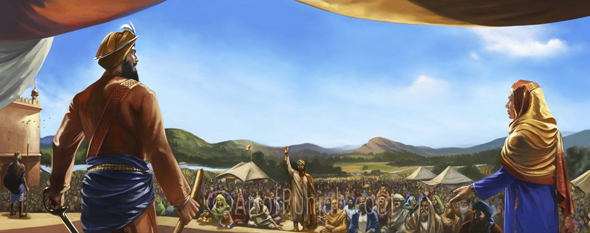
With Vaisakhi upon is, what is it you think of? Perhaps Anandpur Sahib, the city of bliss? Maybe the Panj Piaray, the five beloved ones? Or perhaps it is Guru Gobind Singh Ji’s message of fraternity and equality that resonates with you. Whatever it is that you think of, I wonder if it stirs you or moves you to see the world in a different light – in the light that our Guru hoped for us. On this day, in 1699, our Guru gave us the potential to be born again. Without caste, without discrimination, and without fear.
It is clear that issues of caste and discrimination still play a role in our communities today. However, I came across a promising article in the Guardian which discusses how a small café in India is challenging long-held caste taboos by hiring Dalit women to work within the café as waitresses. Although the Indian constitution banned untouchability sixty years ago, Dalits are still often forbidden, in villages and small towns, from doing anything other than low menial jobs. We all know it is not easy to challenge century-old beliefs, however this café is doing just that. As Sikhs, these issues should matter to us and we should stand up against injustice within any community.
An interesting paper, which I found on the Punjab Research Group site, titled “Dalits and the Emancipatory Sikh Religion” discusses the role Sikhi played in liberating Dalits.
It is beyond doubt that Sikhism emerged as an emancipator for the lowest of the low. Nanak, the first Guru, was clear when he says:
As we remember 1984 through concerts and acts of rebellion, let’s not forget the visceral spirit displayed by Singhs IN that time period.
Watch below the original version of a Punjabi kavita sung by Bhai Gursharan Singh during those turbulent times in Manji Sahib Hall located in the Darbar Sahib complex . This kavita captures the mood and spirit of those days. Tigerstyle later used it in one of their Shaheedi CDs to REMEMBER that spirit.
Intellectually, we can try to REMEMBER those days; but this kavita actually makes us FEEL how it was to live through that time.

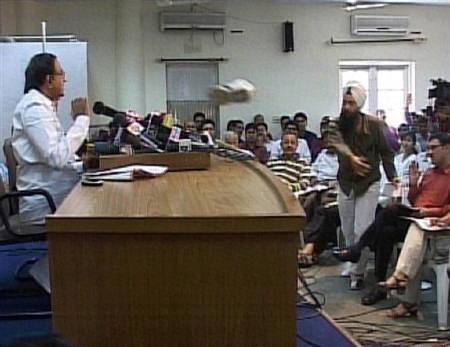 I know many will object to this post and ask how does a shoe bring justice to the thousands that lost their lives in 1984? My reply – it doesn’t.
I know many will object to this post and ask how does a shoe bring justice to the thousands that lost their lives in 1984? My reply – it doesn’t.
But what it does do is highlight the farce that calls itself Indian justice.
Earlier this week, I wrote about Sikh outrage against the Congress Party’s continuance of giving electoral posts to genocidal murders. While I still hold my claim of an independent position against Parkash Badal, the Akali Dal, and the BJP’s opportunism and the Congress Party’s celebration of impunity, the action of journalist Jarnail Singh warrants commentary and analysis.
Last week, I posted on the Gurmat Gian Group’s performance of classical keertan. This all Sikh women’s group, expect 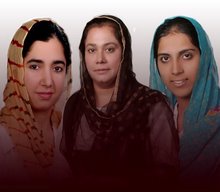 for a tabla player, is based in Ludhiana, Punjab. This week, I wanted to share a brief interview with one of its members, Keerat Kaur.
for a tabla player, is based in Ludhiana, Punjab. This week, I wanted to share a brief interview with one of its members, Keerat Kaur.
1. How did you come to join the Gurmat Gian Group? How long have you been with the group? How often does the group meet?
The Gurmat Gian Group was formed by my mother Gurpreet Kaur. My mother Gurpreet Kaur and myself used to do kirtan in the weekend gatherings of Gurmat Gian Missionary Trust. These programmes are held every Saturday and Sunday. Impressed with our singing, we were asked by the organizers and especially by Rana Inderjit Singh to train young boys and girls to do kirtan. Now Gurpreet Kaur takes regular classes at the Gurmat Gian Missionary College where many girls and boys of different age groups are learning kirtan.
Encouraged to go in to recording Gurabni Kirtan lead to the formation of Gurmat Gian Group which now has 5 CDs to its credit.
SGPC Chief Avtar Singh Makkar recently put forth the stunning idea that the Sikh religion doesn’t permit women to wear jeans. Apparently jeans, along with sleeveless shirts, “attract undue attention and distract others.” [link]
 The background story:
The background story:
…authorities in educational institutions run by the Shiromani Gurdwara Prabandhak Committee are … advising girl students wearing jeans or sleeveless shirts to “go home and change”.
Though the gurdwara body does not have any written rule on the matter, its employees in schools and colleges across Punjab insist hip-hugging denims and bare female arms are too provocative and liable to distract male teachers and students. There have been many recent instances at Ludhiana’s highly-sought-after Guru Nanak Engineering College, where women students were turned out of classrooms and told to stay away unless they went home and changed into “more respectable attire”.
SGPC chief Avtar Singh Makkar actually acknowledges the unwritten rule. “We discourage girls from wearing anything other than the usual salwar kameez because Sikh religion doesn’t permit dresses like jeans, pants or other similar wear.” [link]
What’s wrong with his statement? So many things… only one of which is Makkar’s use of the Sikh religion to promote his personal viewpoint and ultimately, the failure in leadership it illustrates.
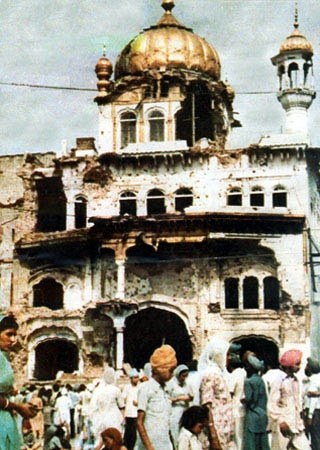 In time for the beginning of the Sikh New Year according to our own Nanakshahi calendar, the Shiromani Gurdwara Parbhandak Committee (SGPC) has released its annual calendar. In this 25th year of remembering the events of 1984, it is a moment for Sikhs to reflect and take lesson as well as maybe something for India to reflect and takes lesson as well (hopefully not the so-called morally-bankrupt, heinous ‘Punjab lesson.’)
In time for the beginning of the Sikh New Year according to our own Nanakshahi calendar, the Shiromani Gurdwara Parbhandak Committee (SGPC) has released its annual calendar. In this 25th year of remembering the events of 1984, it is a moment for Sikhs to reflect and take lesson as well as maybe something for India to reflect and takes lesson as well (hopefully not the so-called morally-bankrupt, heinous ‘Punjab lesson.’)
This year’s calendar includes a picture of the Akal Takht, bullet-ridden and tank-bombed, after the Battle of Amritsar. The call for SGPC recognition has been long overdue. Activists within the Sikh community have been calling for official recognition of the Third Sikh Genocide (Third Ghallughara) for years. Finally the SGPC has taken action.
Unfortunately, the SGPC does not act at the behest of the community, but only at the behest of Badal. In an election year, many are seeing the picture’s inclusion as an attempt by the Akali Dal (Badal) to play upon Sikh public sentiments against the Congress Party in Punjab.
What exactly is the function of a Sikh Student Association? Is it simply to bring Sikh students together on campus for token meetings? Is it to celebrate Vaisakhi by organizing bhangra parties? Is it a platform to mobilize students to act upon issues impacting Sikh youth and the Sikh community? Is it… okay, I’ll stop with the questions.
To be quite honest, I don’t know the answers to these questions. I can speak to what I think the potential of such organizations is – what they could achieve and how an active and effective Sikh Student Organization could impact change. For example, here on TLH we’ve previously discussed how Sikh Student Associations in California have organized student initiated Kirtan and come together for Nagar Kirtans. Last week Camille discussed an initiative taken up by the University of Texas Sikh Student Association (the post stirred up some issues about the role of Sikh student associations). While these events are sporadic and intermittent – they are an example of one of the functional elements of a Sikh Student Organization – to educate ourselves and others about Sikhi.
However, it has to go beyond that. While I think any and all Sikh Student Associations should be given accolade for planning and participating in activities such as weekly Rehraas – there is much more to be achieved. Perhaps what’s integral to the success of these organizations (and to ensure they are effective) is to create an umbrella organization which provides resources and support to local Sikh Student Associations.
Take B.O.S.S. for example,
The British Organisation of Sikh Students is a non-political, non-profit making, independent body which acts as an umbrella organisation helping to develop, assist and support Sikh youth groups. [link]
No longer are Punjabi “staarz” (i.e. Gurdas Maan, Arminder Gill, etc.) or Sukhbir Singh Badal’s Mrs., Harsimrat Kaur Badal (i.e. Nanhi Chhaan project), the only ones focusing on the “girl child”, but also a granthi at a California Gurdwara. I was recently surprised to hear a granthi support the idea of gender equity as part during his Punjabi kathaa of a shabad he was singing. No he wasn’t a renaissance granthi, but a common one you would encounter in your general Gurdwara. The sangat wasn’t full of progressive youth/parents, but consisted of lay-persons. AND the focus of his kathaa wasn’t gender equity, but our needs/yearnings. So you may ask how was he promoting gender equity? Well, he used the yearning for a thee (daughter) or puthar (son) in the SAME example to help the sangat understand the shabad’s message. In my experience, the yearning for a daughter and son are never used together to help the sangat think beyond their wants and just accepting Waheguru’s will. Common examples are a yearning for a betaa or a mother caring for a betaa (we could also add a big house and nice car to the list). I have never heard of a yearning for a betee or caring for a betee. It has been during these kathas that the contradiction between theology and contemporary practice of Sikhi have been poignantly highlighted for me. Yes, theologically we believe in gender equity (it’s in Gurbani with examples in Sikh history). However, the common examples used to intimately relate and rely the Guru’s message to an every-day (opppss … maybe I should say Wednesday and Sunday) sangat reify gender inequity. From my perspective, I was finally hearing a common granthi make an attempt to break away from mold.
